What happened when I purchased an online genetic health risk report? | Promethease review
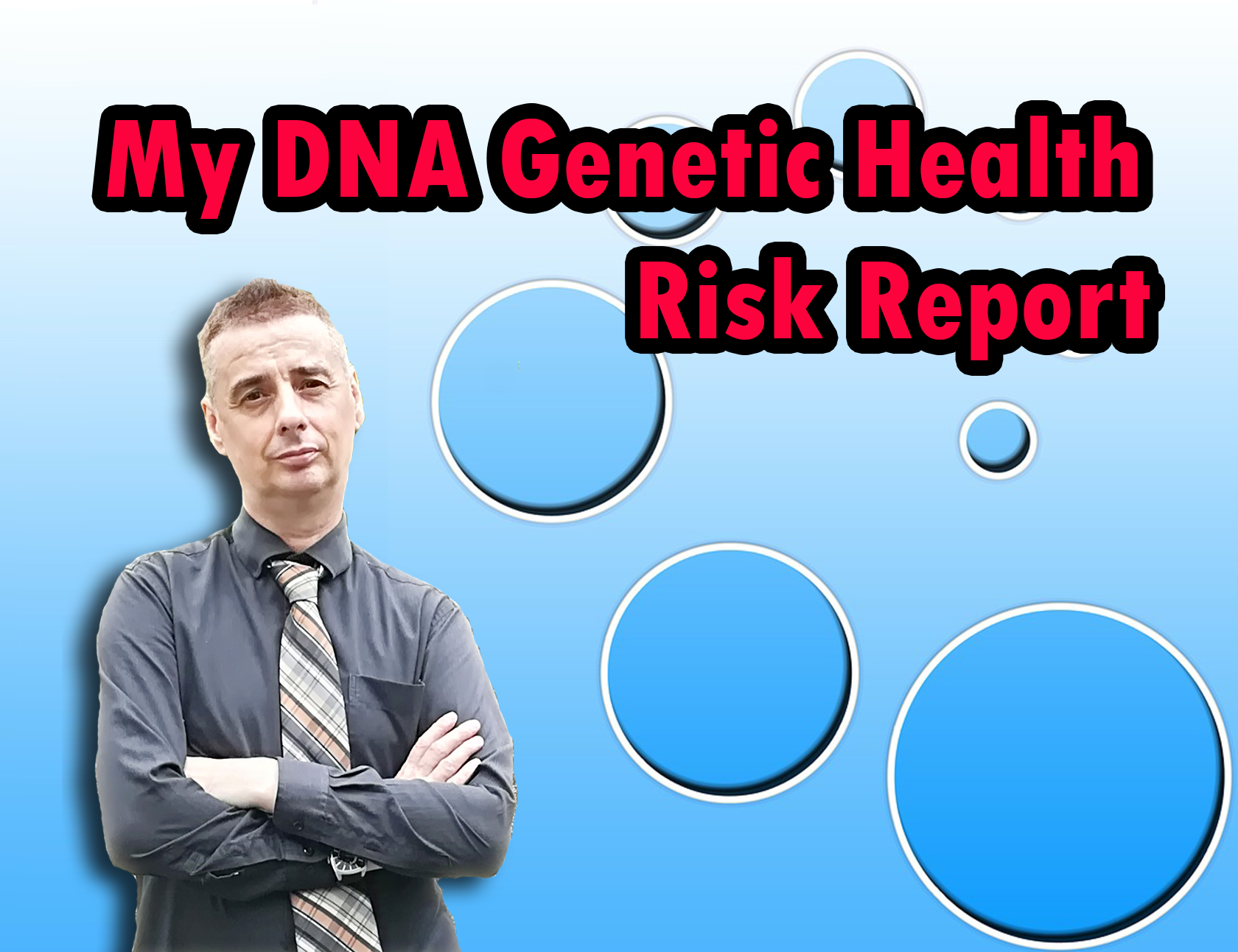
I recently did a home DNA test and once I had the results I purchased an online genetic health risk report. This is what happened…
In my previous post I discussed my experience of doing a home DNA genealogy test through a relatively new company called MyHeritage. I mentioned how I would have also liked to have had a genetic health risk report, but it wasn’t an option at the time because I didn’t want to pay the extra cost. I’ve since then found that there was a much cheaper option for having this and it wasn’t through any of the genealogy companies. This is my review and what I learnt from my results.
After I discovered that genealogy companies, such as 23andMe, also have the extra option of ordering a genetic health risk report, I became intrigued to know what mine would be like. For those of you who don’t know, a genetic health risk report provides information about whether you carry genetic markers associated with risks for certain health conditions. I hoped it would give me an indication of whether I needed to change anything in my lifestyle so as to lessen the risk of developing certain health conditions. I hoped this would also help me to be aware of any symptoms that may appear in the early stages should I begin to develop any of these conditions.
I then discovered a company called Promethease, who could provide one of these reports for as little $5.
This seemed like excellent value, so I dived straight in...
Promethease is described as a literature retrieval system that creates a personal DNA report based on your DNA data, taking into account all the scientific and medical literature cited in SNPedia. For those of you who don’t know, SNPedia is a wiki for investigating human genetics.
When you first visit Promethease, you’ll notice that their website is quite basic and rather old fashioned looking. There is no glossy imagery as found on the genealogy websites. It’s completely functional and nothing else. You are then asked to read and agree with six legal agreement statements, such as that you accept the risk of learning that you may be at high risk for a debilitating disease. After agreeing with all the statements, you are then taken through to another webpage where you can either import your DNA data directly from 23andMe or upload the raw data as a file if you had use one of the other genealogy companies. This last option is what I had to do.
For most people, the cost will be $5, but if you have a much larger data file, such as one from DNA Land, then you can expect to pay $10. That’s still a bargain.
To get my data file I logged into MyHeritage and went to the part of their website where I can manage my DNA kit. Tucked away was the option to download the file. Before you can do this, you’ll be asked to agree that the data you download will not be protected by MyHeritage DNA’s security and privacy settings, so you will probably want to think carefully about where you want to store this file because I’m sure you wouldn’t want it getting into the wrong hands.
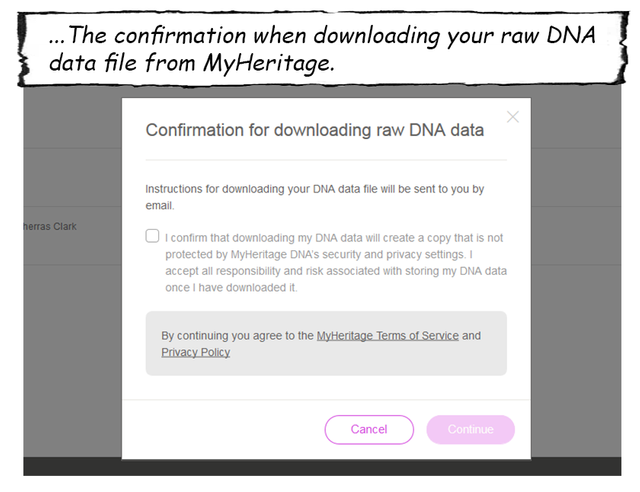
After following their instructions, I was able to download the file which was a single CSV file. I believe this process is fairly similar to the other DNA companies and it was very easy to do.
I returned to the Promethease website and uploaded the file. They notified me by email that it would take about 20 minutes for me to receive the finished report and in fact, after only 10 minutes, I received a second email to tell me that my report was ready.
I suddenly felt quite nervous about what I was about to learn about myself.
The email gave me two choices for viewing the report. I could either look at it online, which would only be available for 45 days, or I could download it as a ZIP file, which inside contained the report as a html file and a directory of its supporting files. To view this file, you will need to use a web browser, but it doesn’t need to be online at the time.
When you first view your report you’ll have plenty of help boxes which take you on a tour to explain each part of the report and how it can be viewed or modified. You can skip these if you want and go straight into reading it.
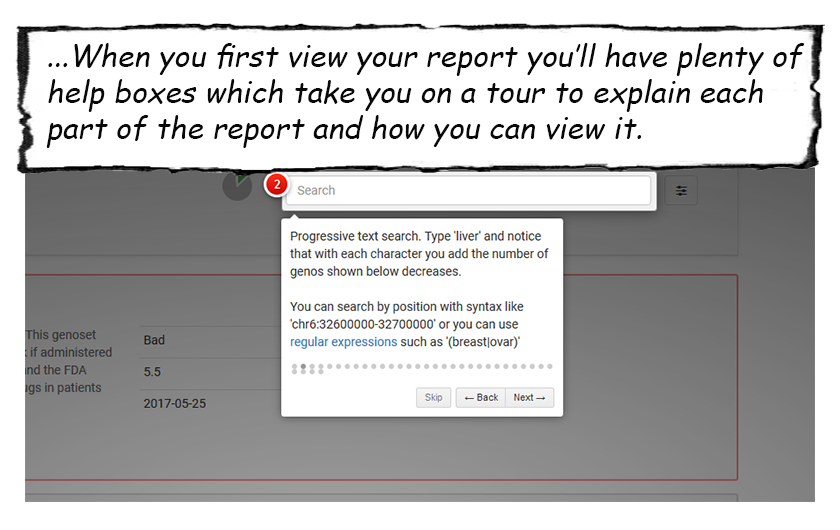
Before I discuss my own results, let me explain how the results were presented.
The results were presented in order of ‘magnitude’ with the highest at the top and then descending down from that. From what I believe, anything which is found in a magnitude of 4 or higher is worth looking at further and might warrant discussing with a health specialist.
I was told that my report contained 12286 genotypes and the highest of these was of magnitude 5.5. This wasn’t so much as a disease, but more of a bad reaction I could have to a specific type of treatment. To be precise, it said that this “genoset predicts the presence of one nonfunctional DPYD allele, and therefore possible toxicity risk if administered chemotherapeutic fluoropyrimidines such as 5-fluorouracil, capecitabine or tegafur”. As you can probably see, it’s quite technical for the average person to fully understand. You can click on a link provided, which will take you through to the SNPedia wiki page to learn more, but again, some of these might be very technical in nature.
My next result was in the Magnitude 4 range and this was to show my gender as being male. This is completely normal and most people – if not maybe all – should be there.
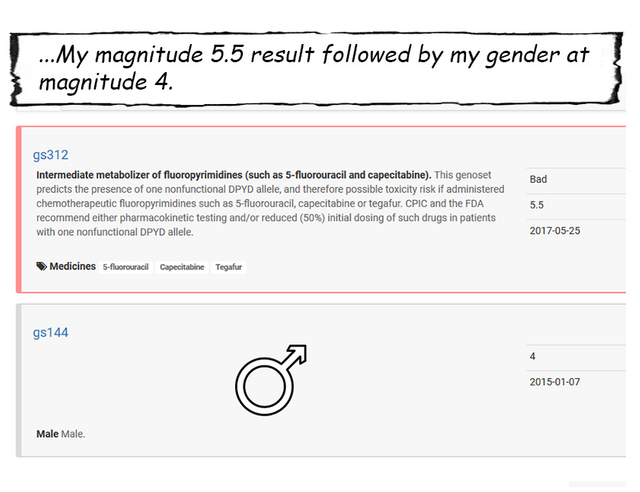
My next results were in the magnitude 3 range, and I believe they shouldn’t be of too much concern, but definitely good to be aware of. I had 11 results in this range of which nine were classified as ‘bad’. These were conditions such as a 1.7x increased risk for heart disease. I also had one which was classified as ‘good’ and this was that I was 11x less likely to go bald. The final one was neither good nor bad, but was classified as ‘not set’.
I did find two conditions that I know I suffer from, although very mildly. As a child I was found to be dyslexic, although this has never been a problem for me in adulthood. The report said that I had a 2-5x increased dyslexia risk and this was in the region of magnitude 2.1. Also, I very occasionally have restless legs syndrome when I’m very tired and this was reported in the region of magnitude 2.
In my adulthood I seem to have developed an allergy to aspirin. I am yet to find that in the report, although I’m sure it will be in there somewhere.
This leads on to how you can organize your results.
The results are colour coded with red for bad; green for good, and gray for not set. To the right of them you have a number of drop-down menus, so you can tailor your results to only show specific conditions, medicines, topics or ClinVar. If you're wondering what ClinVar is, it's a database focusing on genetic diseases. You can also choose to display only your good, bad or not set results separately.

Further down is a small pie chart which displayed my total number of ‘bad’, ‘good’ and ‘not set’. You can see the total number of each of these and their percentage by hovering the mouse over the chart. For me I had the following:
197 Bad (1.60%)
1588 Good (12.91%)
10517 Not set (85.49%)
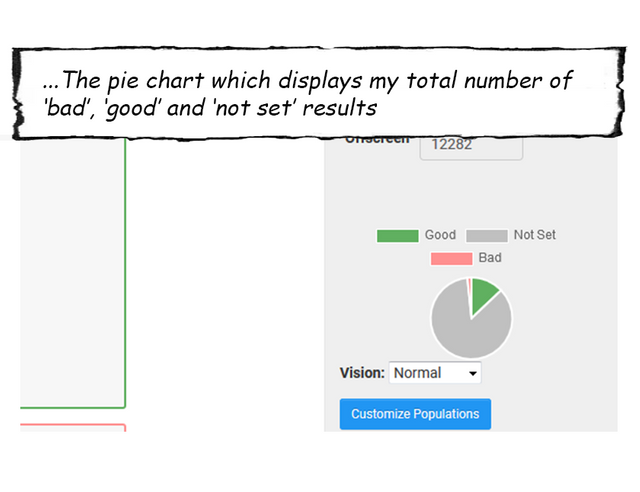
So, what was my final opinion of Promethease?
The delivery of the report was amazingly quick. I was expecting to wait at least a few days and not the 10 minutes it actually took.
Some people who download their report might find it a bit clunky having it as a html file with its supporting files. Having a PDF version would be nice and the email you receive from Promethease does give a link to a page which explains how to generate one, but I found this very difficult to do because I had to install an add-on into my web browser and the finished results were, to be honest, dreadful. Maybe someone else would have better luck.
I thought the report was extremely good value, but to understand your results you will need to educate yourself on how to interpret them correctly. There is no explanation on their site about how to do this and I had to search elsewhere and was able to find some good information on their own sub-forum on Reddit. Without doing this, someone going into this blindly might become quite overwhelmed by the number of results, and especially the negative ones. This could result in them unnecessarily getting into a panic.
Much of the report is written in a very technical nature, but you can probably work out the main crux of each part, but you might still struggle with understanding the detail on some results. This might be exasperated if there is a specific result you are particularly concerned with. This could be especially so if it’s in a magnitude of 4 or higher.
From what I’ve seen, if you purchase a report through one of the genealogy companies, you will probably find that the results are broken down and presented in a much more user-friendly way which the average lay person would understand. Saying that, I still feel that what I received from Promethease was of excellent value (you can’t beat $5!) and the amount of information included was huge.
It now feels good to know whether I have anything of concern and what bad reactions I could be susceptible to when receiving certain treatments. For me, it’s the risk of suffering a toxic reaction to certain types of chemotherapy, so now I’ll be able to warn a doctor in advance. Otherwise, knowing to adjust my lifestyle in certain areas could hopefully go some way in helping to reduce any risks of developing something in later life.
When you view your report, you should bear in mind that other factors, or combinations of factors, could come into play on determining whether you do develop a certain condition or not. It should not be forgotten that there are many variables which are still unknown. Because of this, you are encouraged to re-upload your DNA data file about once every six months or so to generate another report because these reports are continually evolving as more data becomes available. You never know, you might learn something important which you didn’t know before.
In conclusion, this was excellent value for just $5, but be prepared to do your homework.
As a final note, I’m not a medical exert in any way, as you might have guessed, and my analysis of how the results should be interpreted are totally from the point of view of a lay person. If you have better insight on the topic and would like to add something, then please comment below because I would love to hear from you.
Until next time…

Congratulations @tam-lin! You have completed some achievement on Steemit and have been rewarded with new badge(s) :
Click on any badge to view your own Board of Honor on SteemitBoard.
For more information about SteemitBoard, click here
If you no longer want to receive notifications, reply to this comment with the word
STOP